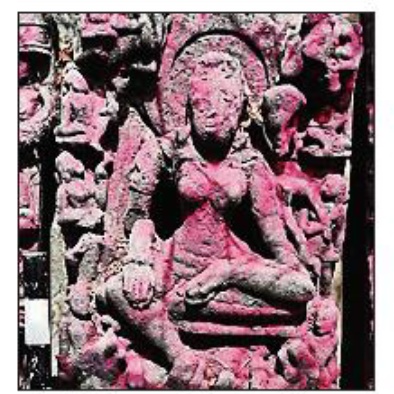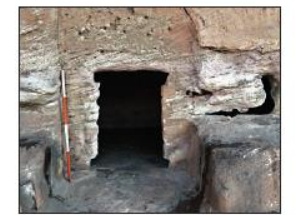Bandhavgarh National Park
This is a collection of articles archived for the excellence of their content. |
Contents |
Buddist idols
2023, 3 idols found in Dhamokhar buffer area
July 9, 2023: The Times of India

From: Amarjeet Singh1, July 9, 2023: The Times of India
Three statues being worshipped by locals in Dhamokhar buffer area of Bandhavgarh tiger reserve have turned out to be those of the Buddha, Avalokiteshvara and Tara, dating back 1,400 years. The ASI chanced upon the statues during a recent survey.
Details
Amarjeet Singh1, July 9, 2023: The Times of India
Bhopal: Three archaeological treasures lay hidden in plain sight for decades, perhaps centuries, in what’s now Bandhavgarh Tiger Reserve until an Archaeological Survey of India team came across them during a recent survey. They turned out to be statues of the Buddha, Avalokiteshvara and the Buddhist deity Tara, dating back 1,400 years. “These statues were found in Dhamokhar buffer area of the reserve. Locals worshipped the deities as ‘Khair Mai’. All three belong to the Tantrayana sect of Buddhism, which is a sub-sect of Mahayana,” superintending archaeologist, Jabalpur circle, Shiva Kant Bajpai told TOI. “We are still studying the statues, but we estimate the idols to be as old as at least the 6th or 7th century”, he said. The survey ended on June 30. The site is around 480km east of Bhopal. In May this year, remains of a ‘modern society’, rock art and two fullfledged stupas were found. Last year, too, several Buddhist caves and structures were discovered, including a votive stupa dating back to 2nd-3rd Century, and Buddhist pillar fragments of the same period, similar to the Chaitya pillars of Bedase caves in Maharashtra.
The site where the statues were found is at an aerial distance of 6-7km from the site where the caves were found, said Bajpai. “Locals of the buffer area recall a myth regarding the idols, saying that some of their ancestors brought it from the ‘upper side’ after a dream. The area where the caves were found earlier is near Bandhavgarh fort. The other evidence, like votive stupas and full-fledged stupas, too, were found in the vicinity of the caves,” he added.
“The evidence clearly suggests that Buddhism was not only present but flourished here between the 3rd and 7th centuries. The place was on the trade route of Magh rulers and the caves used to be shelters. Hence, evidence of a couple of religions has been found here, as travelers left some or the other signs of their own culture and religion,” he said.
Sources said that the written history of the Bandhavgarh region goes back to at least 2nd century CE. From the inscription record found from this region, it is clear that it was under the rule of the Maghas for a very long period, say historians. After the Maghas, many other dynasties ruled here, including the Gupta, Pratihara and Kalachuri rulers.
Excavations
The findings of 2022
Swati Mathur, Sep 29, 2022: The Times of India

From: Swati Mathur, Sep 29, 2022: The Times of India
New Delhi : After a gap of nearly 85 years, the Archaeological Survey of India has restarted exploration and documentation work of ancient caves, remains of Buddhist structures, temples, and statues of Vishnu Dashavataras in the Bandhavgarh reserve forest area of Madhya Pradesh.
The last time ancient structures were explored in what is now notified as the reserve forest area of Bandhavgarh was in 1938, when the exercise was led by ASI archaeologist N P Chakravarti. Led by Shivakant Bajpayee, the superintending archaeologist of the Jabalpur Circle, ASI’s exploration project between May 20 and June 27 this year found, among other things, names of cities like Mathura and Kaushambi inscribed in Brahmi script, 26 new temples, 46 new sculptures and several monolithic sculptures of Lord Vishnu that have not been documented before, and which are believed to date back to the ninth and tenth century CE.
The exploration of nearly 176 sq km of core forest area that was not accessible to thepublic also led to the discovery of the remains of Buddhist structures predating the Hindu rulers of the region, pointing to a harmony of cultures, the ASI officials said.
Bajpayee said the first phase of the exploration exercise — which covered the entire expanse of the Tala Range of Bandhavgarh — also led the ASI team to find a votive stupa. In phases two and three of the exploration exercise, the ASI team will cover the remaining ranges of the Bandhavgarh forest, spanning the Khitauli and Magadhi ranges.
2023: stupas
Amarjeet Singh1, May 8, 2023: The Times of India

From: Amarjeet Singh1, May 8, 2023: The Times of India
Bhopal : Acouple of days after one-of-a-kind rock art and evidence of a 2,000-year-old ‘modern society’ were discovered in the famed Bandhavgarh tiger reserve in MP’s Umaria district, two Buddhist stupas have been found in the ongoing excavation.
These stupas — one 15fthigh and the other 18ft — were used to contain the ashes of monastic heads. Besides these, Buddhist pillar fragments dating to the 2ndand 3rd centuries, quite similar to the Chaitya pillars of Bedase caves in Maharashtra, have also been found. Last year, in a sensational find, several Buddhist structures were discovered, including a votive stupa.
“The structures found this time are full-fledged Buddhist stupas. These were used by common people and monks alike. These are cylindrical stupas and have all the characteristics of typical Buddhist stupas — like a square platform and hemispheres. Also, one more votive stupa was found this time. From stylistic dating, we estimate these two fledged stupas to be from the 7th or 8th century,” superintending archaeologist, ASI’s Jabalpur circle, Dr ShivakantBajpai told TOI. Bajpai added, “Last year, a votive stupa, a Buddhist pillar and a few Buddhist caves were found, but so far, residential evidence of only rock-cut caves has been found. This area was in the trade route of old times. ”
The written history of Bandhavgarh goes back to at least the 2nd century CE. From the inscription record found from this region, it is clear that it was under the rule of the Magha Dynasty for a very long period of time. After the Magha dynasty, many other dynasties ruled this region.